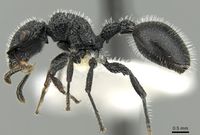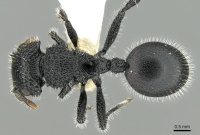Cataulacus muticus
| Cataulacus muticus | |
|---|---|

| |
| Scientific classification | |
| Kingdom: | Animalia |
| Phylum: | Arthropoda |
| Class: | Insecta |
| Order: | Hymenoptera |
| Family: | Formicidae |
| Subfamily: | Myrmicinae |
| Tribe: | Crematogastrini |
| Genus: | Cataulacus |
| Species: | C. muticus |
| Binomial name | |
| Cataulacus muticus Emery, 1889 | |
Cataulacus muticus live in hollow internodes of bamboos and exhibit two interesting behaviors that help ward off occasional flooding threats. Following heavy rains, workers use their phragmotic heads to block the nest entrances and stem water flowing into their nest chambers. A second behavior, also known in Tetraponera attenuata, is communal peeing: Many workers imbibe water within the nest, leave the nest, excrete water droplets and deposit these on the outer stem of the plant (Maschwitz and Moog 2000 and Moog 2005)
| At a Glance | • Bamboo Specialist |
Identification
A member of the granulatus group. A medium-sized species, definitely of the granulatus-group and seemingly closely related to Cataulacus granulatus itself, and yet distinguished by the presence of blunt propodeal tubercles instead of spines, the node of the petiole which is distinctly longer than broad, and the relatively smooth sides of the propodeum. The head, alitrunk and pedicel are relatively coarsely sculptured.
Keys including this Species
Distribution
Distribution based on Regional Taxon Lists
Indo-Australian Region: Malaysia.
Oriental Region: India, Myanmar (type locality), Nicobar Island.
Distribution based on AntMaps
Distribution based on AntWeb specimens
Check data from AntWeb
Countries Occupied
| Number of countries occupied by this species based on AntWiki Regional Taxon Lists. In general, fewer countries occupied indicates a narrower range, while more countries indicates a more widespread species. |

|
Estimated Abundance
| Relative abundance based on number of AntMaps records per species (this species within the purple bar). Fewer records (to the left) indicates a less abundant/encountered species while more records (to the right) indicates more abundant/encountered species. |

|
Biology
In west Malaysia this species lives inside the internodes of two bamboos, Gigantochloa scortechinii and Dendrocalamus asper. They form large monogynous, polydomous colonies that can contain more than 2,000 workers and spread to the internodes of several neighboring culms (Maschwitz and Moog 2000).
Genetics
Polymorphic microsatellites have been identified for this genus (Debout et al. 2002)
Castes
Nomenclature
The following information is derived from Barry Bolton's Online Catalogue of the Ants of the World.
- muticus. Cataulacus muticus Emery, 1889b: 507, pl. 10, fig. 17 (w.) MYANMAR.
- Type-material: holotype worker.
- Type-locality: Myanmar (“Burma”): Tenasserim, Thagata, Mt Mooleyit (L. Fea).
- Type-depository: MSNG.
- Status as species: Dalla Torre, 1893: 138; Emery, 1895k: 473; Forel, 1903a: 706; Bingham, 1903: 124; Emery, 1924d: 298; Chapman & Capco, 1951: 85; Bolton, 1974a: 69; Bolton, 1995b: 139; Mohanraj, et al. 2010: 6; Bharti, Guénard, et al. 2016: 35; Khachonpisitsak, et al. 2020: 84.
- Distribution: India (Andaman Is), Myanmar, Thailand.
Unless otherwise noted the text for the remainder of this section is reported from the publication that includes the original description.
Description
Worker
Bolton (1974) - TL 5.5 - ca 6.0. Head as in granulatus but proportionately larger and with the denticles of the sides of the head behind the eyes larger and more produced. Sides of pronotum and mesonotum strongly denticulate, but the sides of the propodeum with only one or two denticles and converging posteriorly. Propodeum with a pair of obtuse and blunt tubercles (referred to in Bingham as 'slightly produced rounded projecting laminae'). Petiole distinctly longer than broad, rather slender; postpetiole longitudinally oval, truncated in front and behind. Gaster as in granulatus. Head, alitrunk and pedicel very coarsely reticulate-rugose, the pedicel remarkably rugose. Gaster finely punctate and with fine longitudinal rugulae. Pilosity 'rather long', whitish in colour.
Type Material
Bolton (1974) - Holotype worker, BURMA: Tenasserim, Thagata, Mt. Mooleyit (L. Pea) (probably in MCSN, Genoa).
References
- Debout, G., A. Dalecky, et al. (2002). Isolation and characterization of polymorphic microsatellites in the tropical plant-ant Cataulacus mckeyi (Formicidae: Myrmicinae). Mol. Ecol. Notes 2: 459-461.
- Emery, C. 1889c. Formiche di Birmania e del Tenasserim raccolte da Leonardo Fea (1885-87). [part]. Ann. Mus. Civ. Stor. Nat. 27[=(2)(7): 485-512 (page 507, pl. 10, fig. 17 worker described)
- Khachonpisitsak, S., Yamane, S., Sriwichai, P., Jaitrong, W. 2020. An updated checklist of the ants of Thailand (Hymenoptera, Formicidae). ZooKeys 998, 1–182 (doi:10.3897/zookeys.998.54902).
- Maschwitz U & Moog J (2000) Communal peeing: a new mode of flood control in ants. Naturwissenschaften 87: 563-565.
- Maschwitz, U.; Dorow, W. H. O.; Schellerich-Kaaden, A. L.; Buschinger, A.; Azarae, H. I. 2000. Cataulacus muticus Emery 1889 a new case of a southeast Asian arboreal ant, non-mutualistically specialized on giant bamboo. Senckenb. Biol. 80: 165-173.
- Moog, J., L. G. Saw, R. Hashim, and U. Maschwitz. 2005. A triple alliance: how a plant-ant, living in an ant-plant, acquires the third partner, a scale insect. Insectes Sociaux. 52(2):169-176. doi:10.1007/s00040-005-0791-3
References based on Global Ant Biodiversity Informatics
- Bolton B. 1974. A revision of the Palaeotropical arboreal ant genus Cataulacus F. Smith (Hymenoptera: Formicidae). Bulletin of the British Museum (Natural History). Entomology 30: 1-105.
- Emery C. 1889. Formiche di Birmania e del Tenasserim raccolte da Leonardo Fea (1885-87). Annali del Museo Civico di Storia Naturale 27: 485-520.
- Forel A. 1903. Les Formicides de l'Empire des Indes et de Ceylan. Part X. J. Bombay Nat. Hist. Soc. 14: 679-715.
- Mohanraj P., M. Ali, and K. Veerakumari. 2010. Formicidae of the Andaman and Nicobar Islands (Indian Ocean: Bay of Bengal). Journal of Insect Science 10: Article 172
- Mohanraj, P., M. Ali and K. Veenakumari. 2010. Formicidae of the Andaman and Nicobar Islands (Indian Ocean: Bay Of Bengal). Journal of Insect Science 10:172.

